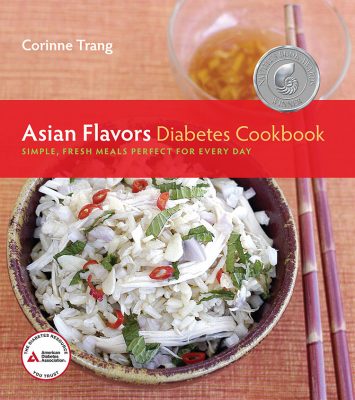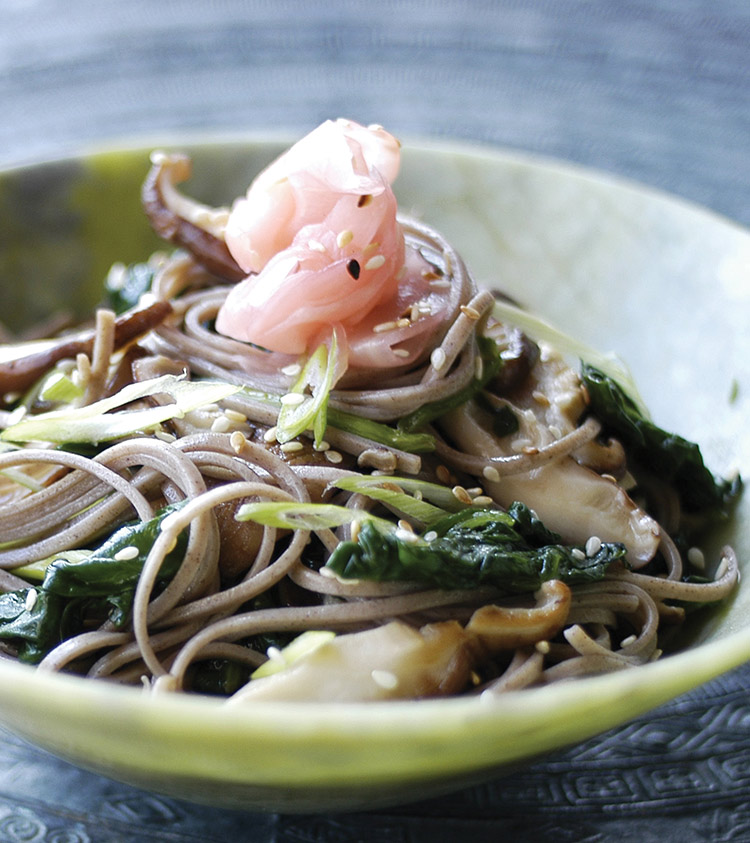A review copy of the sian Flavors Diabetes Cookbook Asian Flavors Diabetes Cookbook was provided by the publisher. No compensation was received and all opinions are my own.
Did you know that Asians are at higher risk of developing type 2 diabetes, and more than half of those with the disease are likely to be undiagnosed? Chances are someone in your family or circle of friends is affected by diabetes. I was interested when I found out about the Asian Flavors Diabetes Cookbook (Amazon affiliate link) by Corinne Trang, who is Cambodian-Chinese and French. So I reached out to Trang to find out more about the inspirations behind this book…
HapaMama: The recipes in Asian Flavors Diabetes Cookbook look delicious! Many people’s first reaction upon getting diagnosed with diabetes is “I’ll never be able to eat good food again!” or really, “I’ll never be able to eat carbs again!” So I was surprised to see recipes for fried rice and noodle soups in the book. Tell me about how those foods fit into a diabetic diet…
Corinne Trang: When someone is diagnosed with diabetes or any other health issues, the first thing they worry about is diet, as well they should. Years of poor eating will lead to any number of health conditions. News flash— the so-called “good food” they worry they won’t eat again is probably not really the best. Luckily, diabetes is not beyond our control. We can control it with properly balanced meals made with healthy ingredients and a new outlook on nutrition and lifestyle.
The problem is not rice or noodles. The problem is junk food including processed packaged foods and fast food. In small, reasonable healthy quantities, you can have whole grains such as rice, or whole grain-derived items such as noodles. This doesn’t apply only to those living with diabetes but to all of us. Eat sensibly, and don’t dial for take-out, grab a box in the aisle, or drive-through. In this country, we are extremists. We’re diagnosed with something and all of the sudden our first thought is “I can never have __________ again.” Wrong! You can, just be mindful and creative about how you approach this craving.
Also think about how you define “good food.” Enjoying food we love requires patience, some education, and a desire to live life differently. Diabetes is a wake-up call. Take advantage of it. Here’s something that people don’t know when they eat authentic Asian food (not American-Chinese take-out). In Asian culture, food is medicine and medicine is food. What goes into the body is there to heal without us ever having to give it a thought. That’s just what’s supposed to happen. All ancient civilizations have used food as medicine. When did we forget this simple fact? Hippocrates is quoted as saying, “Let thy food be thy medicine, and medicine be thy food.” Certainly, he wasn’t talking about cake, cookies, chips, or double-cheese burger and fries!
Scroll down to get the recipe for Soba Noodle Salad with Shitakes and Spinach
from Asian Flavors Diabetes Cookbook
HM: And desserts, too…
CT: I’m a strong believer in eating small portions. When food is really tasty, you only need a couple of bites to satisfy your craving. Desserts in my book are made from scratch and use fresh fruit, which are high in fiber, minerals and vitamins. Portion control is very important for “sometimes” food such as dessert. Pay attention to the serving size.
HM: I was really excited to see authentic Asian flavors in cookbook geared with health in mind. How can familiar flavors (or for some people, different, bolder flavors) help people stick to healthy diets?
CT: Authentic Asian meals follow a basic principle. Be sure that you have all flavor elements including sour (lemon, lime, vinegar), sweet (fresh fruit, or a light dose of any other source), spicy (chilies, black pepper, other spices, or peppery green leaves), salty (naturally occurring in green vegetables), and bitter (rinds, some vegetables). When these are present, then you’ve addressed all that your taste buds crave, in one way or another. You must learn to taste the ingredients in their original state first, and then learn to work with them and adjust seasoning accordingly. Don’t just add salt to a dish before tasting it. It’s when you only taste sugar, salt and fat, that you’re in trouble. These are the three things that people quickly get addicted to (occurring in ALL junk foods, “organic” included). Instead, reflect and understand what your body truly needs.
HM: Any general tips on how to prepare foods that are good for you without sacrificing flavor?
CT: Always grab fresh ingredients. The best kind of cooking can only result from this basic principle. Pay attention to the five flavor characteristics including sour, sweet, salty, spicy, and bitter. The easiest way to make sure that happens is in a sauce or salad dressing, or braising liquid. Understand too that a sauce, or cooking juices, or dressing, will go a long way to add flavor to any dish, so be sure not to drown your meal. You want to taste every element of the dish, not just the sauce.
HM: Several of your cookbooks, including your newest, Switch It Up, focus on healthier recipes for diabetics. How did you get interested in this nutritional specialty?
CT: I’m interested in developing recipes to help people understand what they actually need, and what their bodies truly crave. Poor eating habits and over-indulgence of certain foods lead to any number of health conditions including diabetes. For instance, obesity can lead to diabetes. From diabetes, heart disease can develop. It’s the domino effect because all diseases are related to one another. If one part of our body freaks out, many other parts can as well, if the first condition is left untreated. It’s all up to us. As a chef and cookbook author, I have a responsibility to help-out in any way I can to bring awareness to serious conditions like diabetes.
Soba Noodle Salad with Shitakes and Spinach
SERVES 6
SERVING SIZE 1 1/4 CUP
Soba noodles are made of buckwheat and wheat flours. A specialty of northern Japan, they are hearty, healthy, and nutty in flavor. They can be served cold or in a piping hot broth. This simple dish of soba with shitakes and spinach can be served at room temperature or slightly chilled over a bed of fresh greens and a side of Chicken Teriyaki (page 127). For a more hearty meal, feel free to add any leftover roasted chicken, pork, or beef. Soba noodles come pre-portioned in a package of 3, 4, or more. Figure 1 portion per person, otherwise when adding meat or seafood protein to this dish, use 3 portions of noodles to serve 4.
Ingredients: 6 portions (8 ounces) soba noodles 3 tablespoons grapeseed or vegetable oil, divided use 12 large shitake mushrooms, stems removed and caps julienned 1 pound baby spinach 1 1/2 tablespoons light soy sauce 2 tablespoons rice vinegar 2 teaspoons dark sesame oil 1 teaspoon local honey or agave nectar 1 teaspoon wasabi paste or sriracha (optional) 1 scallion, trimmed and thinly sliced 1/3 cup drained and tightly packed pickled ginger Toasted sesame seeds
Directions:
- Bring a medium pot filled with water to boil over high heat. Add the noodles and cook until al dente, about 3 minutes. Drain and shock under cold running water or in an ice bath (water and ice mixed). Drain well and transfer to a mixing bowl.
- In a large skillet or wok over high heat, add 2 tablespoons grapeseed oil and stir-fry the mushrooms until just wilted, about 1 minute. Add the spinach and continue to stir-fry until just wilted, about 1 minute more. Add to the noodles.
- In a bowl, whisk together the remaining grapeseed oil, soy sauce, vinegar, sesame oil, honey, and wasabi. Drizzle over the noodles, tossing to mix the ingredients well. Divide among 6 individual portions, and garnish with some scallion, pickled ginger, and sesame seeds.
EXCHANGES/CHOICES 1 1/2 Starch 2 Vegetable 1 1/2 Fat Calories 220 Calories from Fat 80 Total Fat 9.0 g Saturated Fat 1.0 g Trans Fat 0.0 g Cholesterol 0 mg Sodium 395 mg Potassium 515 mg Total Carbohydrate 31 g Dietary Fiber 3 g Sugars 4 g Protein 8 g


